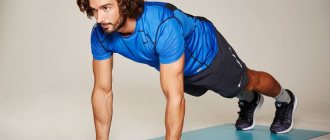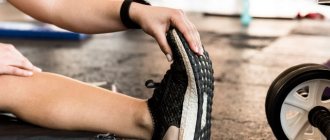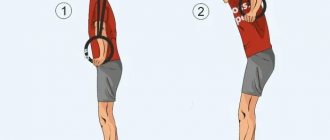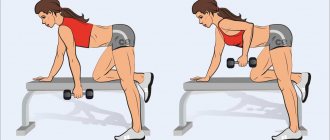Home » Equipment
Technique
Author Ivan Balashov Reading time 13 min Views 252 Published 10/12/2021
Jumping on one leg trains the athlete's endurance and teaches him to better maintain balance during physical activity. Let's figure out what types of exercises are considered more effective and what makes them special.
If you use a jump rope on only one leg, the load increases many times over. Let's figure out which jumping technique is correct and how to hold your head and body correctly during training.
Jump rope on one leg - features of use
You can jump rope not only on two legs, but also on one. This technique is often used by professional athletes during warm-up or regular training. Usage nuances:
- constant control of leg movements;
- heavier load on the foot;
- requires great coordination of your movements.
With this technique, the calf and other leg muscles are pumped well. The boxer gets used to controlling movements and learns to balance during serious physical activity.
Professional trainers consider jumping rope to be the best imitation of the movement during a boxing fight. This is due to the intensity and severity of the sport. When jumping, you give your all, just like in the ring.
Is it possible to lose weight with a jump rope?
This question worries many girls who dream of reducing their waist and hips, and finally becoming the happy owner of a flat stomach.
Jumping refers to aerobic exercise, when the heart actively starts working, pumping a larger volume of blood, and the lungs work. Oxygen enrichment occurs, metabolic processes are activated, energy is consumed - calories are burned, subcutaneous fat deposits are reduced.
Consequently:
- thighs are tightened;
- legs become slimmer;
- acquire elasticity of the buttocks;
- the stomach decreases;
- fat disappears from the waist.
It is estimated that 15-minute exercises with a jump rope for weight loss burn (depending on the intensity of the workout) 150-200 kcal.
For comparison, this is equivalent to 20 minutes of intense running or an hour-long walk at an active pace.
Sixty minutes of jumping rope will burn more than 700 calories, while running will only burn 600 in the same amount of time.
The effectiveness of losing weight increases if you add an exercise bike or treadmill to the jump rope. But exclusively jumping activity produces noticeable results when carried out regularly and competently. Knowledge, supported by strong motivation and an irresistible desire to improve your figure, gives real achievements.
Correct jumping technique
It is very important to jump correctly. Otherwise, there may be sports injuries or uneven load on the muscles. One leg may begin to hurt, while the other will remain untrained.
Incorrect technique also leads to shorter workouts, as energy is wasted. Try to follow the advice of experienced trainers when using a jump rope as a sports equipment.
Body and head position
When jumping on one leg, it is better not to lower your head too low, concentrating on counting the jumps. Don't throw your head back either. It is better to choose a point slightly below eye level and focus on it.
While jumping:
- Keep your body straight, don't slouch.
- As you jump, land on your toes. This will reduce the stress on the foot.
- Don't try to immediately get into a very fast pace. At first, it is enough to stick to a moderate load.
Accelerated jumps at the initial stage will quickly exhaust you and you will not be able to practice for a long time. Increase your speed gradually. Alternate the amplitude of jumps (high/low, etc.). Try to bounce easily.
Hand position
Keep your elbows close to your body and do not spread them too wide when jumping. The hands work at hip level. You don't need to raise them too high.
This helps maintain balance. Movements must be collected and fast. The movement of the rope itself will tell you about the correct technique.
The cord should flash very quickly and almost not touch the floor. This is only possible if you keep your elbows close to your body.
Grip
Hold the handles of the jump rope firmly with emphasis on your index finger and thumb. This will help you fully control the situation, which means you can balance well when jumping on one leg.
Leg movements
There is no need to throw your legs too far or lift them above the knee. Jump to a small height at first.
If you want to increase the load, then:
- During training, you need to alternate double jumps and hops on one leg. You tuck the second leg a little, and, on the contrary, straighten the one on which the lunge is being made;
- also use other variations of jumps (cross from toe to heel, from side to side, etc.). All this helps to diversify your workout and enhance the burning of excess fat.
If you can't do it right away, try jumping without a rope first. Only when everything is fine, start jumping over in the usual way.
How to choose the optimal length?
There are several good ways:
- Take the rope in two hands, lower it to the floor, step in the middle of the cord with both feet. Spread the handles to the side, place them under your armpits. You managed to do it without difficulty, which means the jump rope matches your height. If not, repeat these steps with other products until you find the one you need.
- Take the skipping in your hands and fold it in half. With one hand, grab both handles at once and hang it in front of you at a right angle of approximately 90° (relative to the body). If the bottom end touches the floor slightly and does not hang in the air or lie on the floor, then the length is appropriate.
- If you decide to purchase skipping through an online store , for example, then the following table will help you: height 150 cm, required length – 2 m;
- height 150-167 cm, length – 2.5 m;
- height 167-75 cm, length – 2.8 m;
- height 175-183 cm, length – 3 m;
- height 183 cm, length – 3.5-3.8 m.
Missing or extra centimeters can equally negatively affect your activities. Therefore, be careful when choosing. If possible, immediately buy a jump rope with an adjustable length. This is a more expedient option; any family member can use it, without restrictions.
Boxing jumps
Boxers jump rope, just like all other athletes. But sometimes they also use more complex exercises (jumping from foot to foot, cross, twisting the cord, etc.).
The goal is to imitate the gait of a boxer during a fight. Let's look at the most common techniques that help train your legs and hone the speed of reaction to an enemy's blow.
Running with high hips
This exercise involves jumping, simulating running, and raising your legs high. Promotes good pumping of all muscles of the lower leg and calves, as well as pumping up the abdominal press.
Features of the exercises:
- The “running” movements resemble the dancing gait of a boxer in the “shuttle” in the ring.
- The technique helps develop the reaction and strengthen the athlete’s muscles. We raise our legs to the knee.
Cross
Children at school love to jump with crosses or scissors. This technique increases tension in the muscles and requires greater balancing skills. Bouncing your legs forward and back, as if imitating scissors.
You can also jump on two legs first and then move on to crossing. The pace gradually increases. This technique is called the “cross”.
Rolling the rope backwards
The style of bouncing is complex and not everyone can do it. You need to twist the rope cord back and rise onto your toes. Then he is caught behind the body already in the jump. You seem to twist the cord back with intense movements.
Double Jumps
The whole point is to manage to jump not once, but several times while moving. You don't need to jump too high to do this. Small jumps are enough in one pass of the rope.
The easiest way to practice the technique is first without a cord:
- Do three low jumps and one high jump.
- After it starts to work out, you need to add one more to the high jump. Rest between sets 1.5-2 minutes.
On the topic: methodological developments, presentations and notes
Consultation “How to teach a child to jump rope”
Jumping rope allows children to develop coordination, agility and speed. This is a wonderful exercise for both girls and boys...
Consultation for parents “How to properly teach a child to jump rope”
A ROPE FOR CHILDREN IS THE DOOR TO THE WORLD OF SPORTS! If parents and children play sports together, this is almost a guarantee of a good result, because children copy their parents and take their example from them. Behind…
“How to teach a child to jump rope”
Sport is very important for children; it develops useful character traits: perseverance, determination, patience, discipline, the ability to overcome difficulties and many others. When children engage with...
Other jumping options
Boxers and martial artists also practice other types of jumping rope. The load often changes, new exercises are added, and the pace or complexity of the jumps themselves may increase.
Running in place
Take a jump rope and imitate running in place. This is a fairly easy exercise when compared to others. You can start warming up with it. “Running” is enough for 5-7 minutes.
With this technique, you do not get tired, but you learn to control the movement of your legs and hone easier and faster movements that will be useful for the ring.
Jumping with legs forward
This exercise simulates a small lunge. It’s like you’re dancing a Ukrainian dance, stepping from heel to toe. Movements are light and fast.
When jumping over a rope, you move one leg forward a little and then roll over. The exercise is more complex than the previous one, but it perfectly works the abdominal muscles and trains the foot to be flexible.
Boxing jumps
A jump rope is a constant companion of a boxer's training. The most typical warm-up exercises are jumping alternately on one leg or the other and small but fast jumps on both legs.
Boxing jumps with alternating heel and toe
This technique is also called Cossack. The reason is to imitate heel-toe dance movements. When jumping, the athlete first touches the floor with the toe of his foot, and then the load moves to the foot.
The speed of movement is developed, the legs become light, and the athlete learns to follow them and control his every step.
High hip lift
When training with a jump rope, it is not customary to lift your legs too high. Mostly small or medium-length jumps up to the knee are practiced.
But this technique involves working the upper muscles, and it requires raising the thigh of one leg as high as possible. The abs also become tense.
With changing legs back and forth
You can first jump forward on one leg, and then make the same movements, but back. This will diversify the workout and increase the load on the calf and other muscles.
"Legs together - legs apart"
When you jump, you move your legs together and apart as you jump. At the same time, you need to have time to jump over the cord.
The result is an unusual jump and at the same time the lateral muscles of the thigh are trained. If you move quickly, the movements are a bit like dancing.
From side to side
The movement is reminiscent of jumping from one “classics” cell on the asphalt to another. You jump up, pass the cord, and lunge the other way. An excellent imitation of real boxer jumps in the ring.
Back and forth
This is the simplest version of the warm-up exercise. You first jump forward and then suddenly change direction. This perfectly trains the boxer's reactions and makes him concentrate better.
With crossed legs
This is a complex technique. It’s better to first try jumping up and crossing your legs in a cross without using a jump rope at all. After understanding the basics, you can try jumping with a cord.
If you jump on one leg, the toe of the other should point down. We try not to fall through the jump and not sway from side to side.
With arms crossed
You don't just hop on one leg, but also cross your arms. At first you just jump, but in the next approach of the jump rope you make a “cross” with your hands along with the cord.
This is not easy to learn. I'll have to practice. The reward will be pumped up shoulders, as well as improved hand coordination.
With side swings
You can also jump on one leg with side swings. The knees and feet should be straight and tense during movement. You swing the rope and jump at the same time. There is no need to jump over the cord.
Question to the expert
I can’t jump on my toes—I always end up on my heel. What to do?
It's a matter of focusing on the task at hand and staying focused. This is why the jump rope is so valued in boxing. All famous boxers use it not only for physical exercise, but to train mindfulness. Try to focus on your feet as you jump and make the bounce soft, cat-like. The easier the jump itself, the easier it will be to land on your toes. Practice and gradually the correct technique will develop by itself.
Types of jump ropes
Simple
Their length is usually not adjustable; the material is often plastic or rope of various structures. For handles they use: rubber, less often leather. The rubber is inexpensive, but does its job remarkably well.
Express
Endowed with higher rotation speed. Small bearings are mounted in the handles. This means the load will be more intense. Due to the number of revolutions per unit of time (4-6 revolutions per second).
Only with it it will be impossible to do more complex exercises. It is only suitable for normal jumping. If you have no experience in handling it, you can get a rather sensitive blow to the body.
The length is not adjustable, but the cord can be replaced, it is made:
- leather;
- plastic;
- steel, with vinyl shell.
Weighted
Their weight is more noticeable (up to 3 kg), so it will not be easy for an untrained person to handle them.
The handles and the cord itself become heavier. Weights, such as various inserts, are inserted into the handles. The cord is initially made from heavier materials.
Its main function is to increase the load on all involved muscles of the body. There are models with adjustable length and not.
Jump ropes with a counter built into the handles
- mechanical – will be able to accurately display the number of revolutions made over a certain time;
- electronic – shows: the number of calories burned, the number of revolutions, the duration of the jumps.
A weighted jump rope is equally suitable for amateurs and athletes. With its help you can easily calculate the required load.
To do this, enter all the person’s initial data before starting:
- height;
- weight, etc.
And skipping itself will calculate the number of calories used. To know how long it will take to “burn” extra calories. Losing weight will be more meaningful. The length is not adjustable. The price with an electronic meter is understandably higher than the usual one.
Leather
Made from leather accordingly. Popular with boxers. The power effect is achieved by reducing the weight of the cord, but increasing the weight of the handles. There are models with adjustable length and not.
How to use a jump rope in training?
The jump rope is constantly used during warm-ups and cool-downs before entering the ring or simply to keep in shape. Jumping is also a good way to take your mind off everyday activities and switch your attention to sports.
Warm-up and cool-down
Warm-up is a mandatory 15-20 minute program for all wrestlers. Usually, jumping rope is combined during this period with other types of sports activities.
For example, an athlete can swing his arms and legs, rotate and twist the body, jump from a sitting position, and much more. The goal is to warm up well before the fight, and not get tired and lose all your strength.
Required and:
- Push-ups, as well as other loads.
- Jumping rope alternates with running on a cardio machine or stadium.
The warm-up is short in time. But sometimes, if an athlete is faced with the task of losing excess weight, he can increase the time he works with the rope.
After training, a cool-down is carried out when the muscles are stretched with special exercises. This is a calmer period of working with the body.
Usually the jump rope is not used at this time, since the athlete’s task is to transfer the body to a calmer mode and go on a well-deserved rest. The cool-down lasts the same amount of time as the warm-up.
Cardio
Regular cardio on a machine is a good way to warm up your muscles before a fight. The goal is not to lose weight, but to get ready for the workout. Therefore, usually no more than 20 minutes are given for this type of load.
They also simply run around the hall, on the spot or in the stadium. Cardio exercises can be easily combined with skipping rope. For example, you can imitate running, jumping higher and then switching to “jogging” again.
Benefits of running:
- Cardio is indispensable for endurance training and can be used not only for warming up, but also for morning or evening sports activities.
- You can also easily control your weight if you include cardio in your daily routine.
HIIT with jump rope
Interval training with a jump rope alternates intense jumping with short pauses to restore breathing. This load promotes rapid weight loss, elimination of shortness of breath and strengthening of muscles.
Active jumping usually occurs for half a minute, and then there is a ten-second rest. The peculiarity of this workout is that it is very intense. 10-15 minutes is enough.
General benefit
Properly carried out physical activity is useful not only for weight loss, but also for the body as a whole:
- the heart and the entire vascular system are strengthened;
- muscles become stronger;
- the lungs are cleansed;
- metabolism accelerates;
- coordination develops.
All these processes have a beneficial effect on tone, increasing immunity and general emotional background. Regular training of the vestibular apparatus improves memory and relieves dizziness.
The figure is corrected in the direction of increasing attractiveness:
- weight loss;
- posture is straightened;
- cellulite disappears;
- the body contour is tightened;
- varicose veins are reduced;
As a result of all these positive changes, girls and women who practice jumping rope can easily withstand stress, are constantly positive, and achieve significant success in their professional field.
Reviews
People's reviews about jumping rope:
Alexandrova Anastasia
Nutrition and healthy lifestyle specialist and author of myfitnesblog.com. For many years, she has successfully helped women and men lose weight and maintain a beautiful figure.
Contraindications
- many diseases of the cardiovascular system;
- hypertension;
- previous injuries, fractures: spine, joints, etc.
- rachiocampsis;
- frequent migraines;
- thrombophlebitis;
- postoperative sutures that have not healed for a long time;
- diseases of the musculoskeletal system;
- weight more than 100 kg;
- many chronic diseases;
- after eating.
If you have such diseases, you need to consult with your attending or supervising doctor about the advisability of exercising at all. You cannot ignore their advice; if they forbid it, then you must obey.
If this type of load is not contraindicated for you, but you just need to reduce the load, or choose an individual selection, go for it. Listen only to yourself, if you experience heart pain, dizziness, etc. stop training immediately.
You must always remember that the load must be increased gradually. And do not exercise to the point of complete exhaustion.
After another workout, you should not feel a loss of strength, but rather a surge of strength and euphoria. This is an indicator of the effectiveness of your persistent actions. This is the only way to get the ideal shape and allow yourself to wear tight dresses and shorts. And in the morning you always wake up easily and with pleasure!











